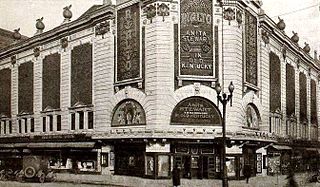
James Edward Boyd was an Irish-born American businessman and politician in early Omaha, Nebraska. The founder of Boyd's Packing House and Boyd's Theater and Opera House, he served as the Mayor of Omaha from 1881 to 1883 and from 1885 to 1887, and as the seventh Governor of the state of Nebraska in 1891 and from 1892 – 1893.

Thomas Rogers Kimball was an American architect in Omaha, Nebraska. An architect-in-chief of the Trans-Mississippi Exposition in Omaha in 1898, he served as national President of the American Institute of Architects from 1918–1920 and from 1919-1932 served on the Nebraska State Capitol Commission.

The Dr. Samuel D. Mercer House was built in 1885 in the historic Walnut Hill neighborhood of Omaha, Nebraska, United States. Samuel Mercer was the chief surgeon of the Union Pacific Railroad, and the founder of Omaha's first hospital.

The Flatiron Hotel is located at 1722 St. Mary's Avenue in downtown Omaha, Nebraska. Designed by architect George Prinz and originally constructed in 1912 as an office building, in 1914 it was renovated for use as a hotel. Today the building serves as office and commercial space, as well as housing an upscale restaurant, Flatiron Cafe, in downtown Omaha. The Flatiron Hotel was added to the National Register of Historic Places in 1987.

The Rose Blumkin Performing Arts Center or The Rose, also known as the Astro Theater, originally opened as The Riviera. It is located in downtown Omaha, Nebraska. Built in 1926 in a combination of both Moorish and Classical styles, the building was rehabilitated in 1986.

The Cozzens House Hotel, later known as the Canfield House, was a pioneer hotel located at 9th & Harney Streets in downtown Omaha, Nebraska. Constructed in by Union Pacific promoter George Francis Train, the 120-room hotel cost $60,000 to build in 1867. The hotel was widely regarded as the finest hotel between Chicago, Illinois and San Francisco, California when it was constructed.

Dr. George Lorin Miller (1830–1920) was a pioneer physician, editor, politician, and land owner in Omaha, Nebraska. The founder of the Omaha Herald, which later became part of the Omaha World-Herald, Miller arrived in Omaha in 1854, the year the city was founded. He also promoted Omaha as the route of the First Transcontinental Railroad and the Trans-Mississippi and International Exposition in Omaha in 1898.

The Burlington Headquarters Building, also called Burlington Place, is located at 1004 Farnam Street in Downtown Omaha, Nebraska. This four-story brick building was originally designed by Alfred R. Dufrene and built in 1879 next to Jobbers Canyon. It was redesigned by noted Omaha architect Thomas R. Kimball in 1899, and vacated by the railroad in 1966. The building was listed on the National Register of Historic Places in 1974, designated an Omaha Landmark in 1978, and rehabilitated in 1983. Today it is office space.

The Paxton Hotel, formerly known as Paxton Manor and currently known as The Paxton, is located at 1403 Farnam Street in Downtown Omaha, Nebraska, United States. Designed by local architect Joseph G. McArthur, the current building was constructed in 1928, with its predecessor dating from 1882. Named for local businessman and community leader William A. Paxton, today the building houses luxury condominia. It is one of the few significant Art Deco structures in Omaha today. Among some of the prominent guests who stayed at the Paxton were Buffalo Bill Cody and William Jennings Bryan, as well as President William McKinley stayed at the Paxton during the Trans-Mississippi Exposition in 1898.
The Redick Mansion, also known as the Mayne Mansion and Redick Hall, was located at 3612 North 24th Street in North Omaha, Nebraska. It served as the first home of Omaha University, now known as the University of Nebraska at Omaha, from 1909 through 1917. A five-story tower on the front of the mansion was a notable landmark throughout the area.
The Herndon House, later known as the International Hotel and then the Union Pacific Headquarters, was an early hotel located at Ninth and Farnam Streets in present-day Downtown Omaha, Nebraska. Built in 1858 by Omaha pioneer Dr. George L. Miller along with several associates, it was financed by the sale of city-donated land and a $16,000 loan. It was used as the headquarters building of the Union Pacific Railroad for more than 50 years; it was demolished in 1922.

The original Carnegie South Omaha Public Library, designed by Thomas R. Kimball, was built in 1904 at 23rd and M Streets in South Omaha, Nebraska. A Carnegie library, it was razed in December 1953; a new library constructed in the same spot opened in October 1954. The second library building was officially closed on May 17, 2008, when a new branch was opened at 2808 Q Street.
Mendelssohn, Fisher and Lawrie was a significant architecture firm in early Omaha, Nebraska. Fisher & Lawrie continued. A number of their works are listed on the National Register of Historic Places.

The Roman L. Hruska Federal Courthouse is a 350,000 sq ft (33,000 m2) Federal Courthouse located at 111 S. 18th Plz. in Downtown Omaha, Nebraska. Completed in 2000, the six story courthouse serves the United States District Court for the District of Nebraska, and features nine courtrooms and a central atrium; built at a cost of $70 million. It was dedicated October 24, 2000, in front of an audience of over 400 people. The courthouse is built on the former site of several historic buildings, including the Hotel Fontenelle, razed in 1983. and the Omaha Athletic Club, razed in 1992. It was the first courthouse in the country to be built under the GSA’s Design Excellence Program.
The Minne Lusa Pumping Station was located along John J. Pershing Drive in the Florence neighborhood of North Omaha, Nebraska. The station, which was surrounded by settling basins, was the main source for pumping, filtering, and distributing Missouri River water throughout the City of Omaha. The station was the namesake of the Minne Lusa neighborhood located immediately to the south.
Westlawn-Hillcrest Funeral Home and Memorial Park is a funeral home, cemetery and crematory located at 5701 Center Street in Omaha, Nebraska.
The Omaha Athletic Club was a social club building located at 1714 Douglas Street in Downtown Omaha, Nebraska, United States. The idea of such a building in downtown Omaha originated in 1915 when a group of Omaha businessmen, including George Brandeis, met to discuss its establishment.

The Rialto Theater was a movie theater at 1424 Douglas Street in Downtown Omaha, Nebraska. The building was razed in 1986 and the site paved over for use as a parking lot. The property was later redeveloped as part of the construction of the Union Pacific Railroad's headquarters building.
The World Theater was a vaudeville and movie theater at 1506 Douglas Street in downtown Omaha, Nebraska. Its name was changed to the Omaha Theater in February 1935 when it was sold to new management. It closed on February 26, 1978 and was razed in 1980 to allow for the construction of a parking garage.














